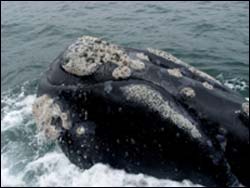In the wake of Hurricane Katrina — probably the greatest natural disaster in U.S. history — a leading ecologist says that one of the best things that could happen to New Orleans and the rest of southern Louisiana and Mississippi would be more rain.
“People might think I’m kidding, but I’m not,” said Dr. Seth R. Reice, associate professor of biology at the University of North Carolina at Chapel Hill’s College of Arts and Sciences.
“The floodwater still covering much
Scientists using satellite imagery found that at least 23 percent of the water released from the mouth of the Mississippi River from July through September 2004 traveled quite a distance – into the Gulf of Mexico, around the Florida Keys, and into the Atlantic Ocean.
The researchers combined data from the Moderate Resolution Imaging Spectroradiometer (MODIS) aboard NASA’s Terra and Aqua satellites with information collected from ships to study the water discharge, appearing

The number of Category 4 and 5 hurricanes worldwide has nearly doubled over the past 35 years, even though the total number of hurricanes has dropped since the 1990s, according to a study by researchers at the Georgia Institute of Technology and the National Center for Atmospheric Research (NCAR). The shift occurred as global sea surface temperatures have increased over the same period. The research will appear in the September 16 issue of the journal Science, published by the AAAS, the science
Surrey Satellite Technology Ltd (SSTL) and the University of Surrey (UniS) cordially invite members of the media to the live televised launch of the China DMC+4 earth observation satellite on Tuesday, 27 September at 7.52 a.m. at UniS School of Management.
China DMC+4, which will be launched from Plesetsk in northern Russia, will be used both to monitor preparations for the 2008 Beijing Olympic Games, and will be the most advanced satellite to form part of the Disaster Monitoring

Like the flashing of fireflies and ticking of pendulum clocks, the signals emitted by multiple nanoscale oscillators can naturally synchronize under certain conditions, greatly amplifying their output power and stabilizing their signal pattern, according to scientists at the Commerce Department’s National Institute of Standards and Technology (NIST).
In the Sept. 15 issue of Nature,* NIST scientists describe “locking” the dynamic magnetic properties of two nanoscale oscill

Crablike ’whale lice’ show how endangered cetaceans evolved
University of Utah biologists studied the genetics of “whale lice” – small crustaceans that are parasites on endangered “right whales” – and showed the giant whales split into three species 5 million to 6 million years ago, and that all three species probably were equally abundant before whaling reduced their numbers.
The five-year study, published in the October 2005 issue of the journal Molecular Ecology,